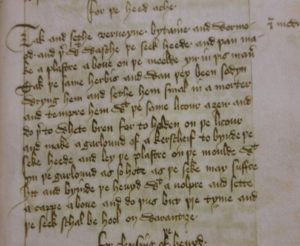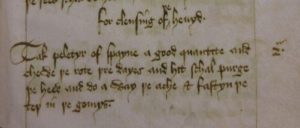(Disclaimer: do not try this at home or any other location – medieval treatments were just as likely to cause illness as to cure it)
Note: this blog was published prior to the 18th of August, and was posted in sequence with the Tudor Herbe Wives event (which has now passed)
Our Cathedral has an incredibly old library. It officially began archiving texts in 1072, and as you would expect, it has a bounty of books, manuscripts and other delights from a variety of eras, including a huge collection from the medieval period.
Many of these books are medical miscellanies and ‘herbals’, a compendium detailing herbs and their many uses. In honour of the upcoming Tudor Herbe Wives performance and talk, we thought it would be appropriate to share a list of medieval treatments that may be helpful to you or your family members in this transitional period from heatwave summer to heatless winter.
Number One, a treatment for headaches
Summer to Autumn. That time when grey skies move in. The air is cooler, the grass wetter, the days shorter and the nights longer. This sudden change to your body’s sleep cycle can be a perfect set-up for painful cluster headaches. Here’s a fix from the 14th-15th century to counteract that pesky ache of the heede.


Transcription:
‘Tak and seche verveyne, bytame[n] and wormood and þ[er] w[i]t[h] wasche þe seck heede and þan make a plastre aboue on þe moolde yn in þis man[ner] tak þe same herbis and wan þey been sodyn wryng hem and sethe hem final in a morter And tempre hem w[i]t þe same litone azen and do þi[s] to whete bren for to holden on the liton and make a garlound of a kercheif to bynde þe seke heede and ley the plastre on þe moulde w[ ]t yn þe garlound as so hote as the seke may suffic hit and byinde þe heuyd w[ ]t a nolþre and sette a cafpe aboue and do þus but þe tyme and þe seck schall be hool on warantiye.’
Translation:
‘Take and [seche]* vervaine, betony[?] and wormwood and there with wash the sick head, and then make a plaster above on the mould in this manner
Soak the same herbs and when they been sodden wring them and [sech] them finely in a mortar and temper them with the same liquor again and do this to wheat bran for the hold on the liquor and make a garland of a kerchief to bind the sick head and lay the plaster on the mould within the garland as so hot as the sick may suffer it and bind the head with another and set a cap above and do this but three times and the sick shall be healed on warranty.’
*This is likely to mean ‘dry’, or be related to the process of drying.
We’d like to call it an easy fix, but in practice, this treatment might not be worth the headache.
Part two to follow soon – a treatment for your common cold
If this subject interests you, you might consider coming to our Herbal Wives talk and performance this Saturday (August the 18th), and our medical series dotted throughout the coming months, including October’s Medical Matters and Treasures of the Cathedral’s Medical Collections talks, and November’s Medieval Medical Manuscripts event.